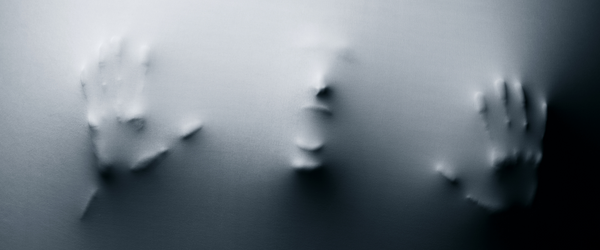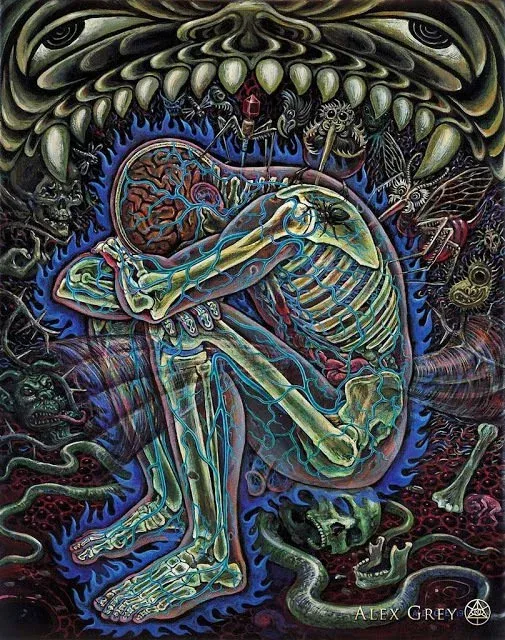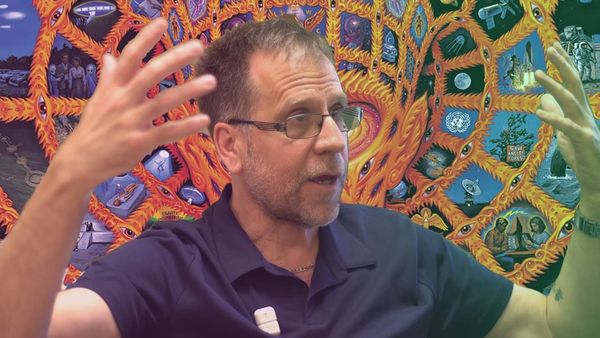Jon Waterlow • • 14 min read
Why We Should Cut Through The Taboo We’re All Scared To Talk About

I’m sitting next to a newly-made friend when suddenly he catches sight of the thick vertical scars running down the inside of my left forearm. His own arm shoots forward, finger pointing, and his wide eyes haul mine upwards as he asks “What’s that?”
Perhaps he thinks I’d been in a fight, a dramatic accident, or that some other exciting story would explain away the wounds I gouged into my own arm one night with a kitchen knife. But perhaps he knows exactly what he’s looking at and is about to deliver the most common response to self-harm: to dismiss it as rather pathetic, attention-seeking behavior.
Anyone who’s cut themselves knows what happens next: emotions cascade as I struggle to respond. There’s a few possibilities. Defensive: “Well what the fuck do you think they are?”; Escapist: “Oh, nothing – burns I got years ago” (unconvincing); Calm: “Depression. I’ve cut myself during some difficult times”. But whatever the reaction, normal service has been suspended and something very difficult has, suddenly, to be addressed. Even if scars don’t hurt, the feelings behind them still do. But more importantly, this isn’t a conversation I want to have at a moment’s notice: it’s a subject so sensitive that to be dealt with at all it needs space and calm… I don’t want to take a sharp detour out of a perfectly enjoyable day and wander through the memories and explanations of some of the darkest moments in my life.
But my friend asks the question for a good reason: he doesn’t understand. And I struggle to answer, because I don’t know how to explain. So we sit there, separated by a chasm of misunderstanding and confused emotions. This is a situation repeated time and again around the world. Self-harm is extremely pervasive, but badly understood and under-supported from an emotional standpoint. It remains taboo to talk about and, like any behavior which marks people out as different, it frequently provokes fear and judgment.
So how could this conversation happen differently? This article is my attempt to increase understanding and empathy on both sides, by describing the experience and meaning of self-harm as best I can. This isn’t just for people who’ve never done it, though. People who self-harm don’t get a handbook in the post which helps them to understand and cope with the destructive emotions inside them, or how to ask for help without feeling ashamed or frightened by the incomprehension which tends to be the response. We need to make some space for a more positive and empathetic conversation on both sides.
WHAT IS SELF-HARM?
“Self-harm” is a broad category – it could include anorexia or bulimia; abusing alcohol and other drugs; or even excessive exercise. I’ve done all these things and sometimes still do, but for me cutting or physically beating myself has been the most emblematic and revealing of the mentality of self-harm, so that’s what I’ll be focusing on. Of course, everything here is directly colored by my own experience and won’t be representative of everyone who self-harms, either in terms of how it feels or how they do it. But from all I’ve learnt and read, the underlying themes are remarkably similar.
WHY SELF HARM?
The whitish, raised scars my friend pointed at are the most prominent, but behind and between them run a latticework of thinner, older scars, crisscrossing each other in all directions. There’s more on my upper arm, which, if you don’t look too closely, might have been caused by running through a particularly incisive thorn bush. And then there’s the more innocuous but no less memorable signs across my hands: not just scars, but the missing, displaced knuckle on my right hand where I broke it from punching walls over and over again in rage, desperation, and despair. It’s a cliché to say you know something like the back of your hand, but the back of my hand tells me a complicated, painful story every time I look at it.
So why did I do it?
According to the UK’s National Health Service, over half of people who die from suicide have a history of self-harm, but self-harm is usually not a suicide attempt. As the NHS website notes, “the intention is more often to punish themselves, express their distress or relieve unbearable tension. Sometimes the reason is a mixture of both.” Paradoxically, it can both help relieve overpowering emotions, but can also help to escape from numbness. The smothering weight of depression can be slashed open by the knife, letting in sharp cold air that both stings yet releases the tension. Self-harm has its own meanings and rationales which are related to but different from suicide and a straightforward urge to punish oneself for being an unworthy or “bad” person, but they’re seldom discussed, and the emotional realities of the act reach beyond this rather bland dictionary definition.
Self-harm is also: (1) A way to make pain more manageable; (2) A way of bringing one’s external reality into closer alignment with one’s internal reality; and (3) Is a form of communication. Unless we appreciate these aspects, we don’t just end up in awkward conversations, but in painful confrontations that can easily escalate into further emotional and physical harm.
But before we explore these perspectives, let’s be clear: we can try to explain and understand self-harm, but that’s not the same as making a case for it being rational. It has a rationale, but it is not rational. In many ways it’s an addiction: a repetitive behavior aimed at assuaging negative feelings, performed compulsively despite yielding only – at most – temporary relief. And addictions can only be helped by exploring their root causes: so what does this addiction express?
(1) MANAGING PAIN
We often picture depression or anxiety as something static: a person frozen in place by crippling doubt and fear. But for me and others it can easily take on a more volatile, physical aspect: punching walls, slamming my head off things, cutting my arms with knives. Why? Because it feels like the emotions are overflowing and they have to come out somehow. I once heard someone explain self-harm as trying to “cut the pain out”, which I understood completely. It’s driven by a complex mixture of believing you deserve to feel the pain and the fact there’s something more reassuringly “real” about physical pain; it’s more tangible, more graspable than the mental agony. Why would I want to be bleeding from my head by bashing it off a wall? Because I already am bleeding inside, but no one can see, and it hurts less to hurt physically.
At the neurological level, the brain doesn’t seem to distinguish between emotional and physical pain. So it makes all the more sense that when it seems impossible to get a hold on mental pain, that one might try to transmute it into physical pain instead. This is something the body does all by itself, too, when stress or repressed emotions start to manifest as physical ailments, from depleted immune systems to chronic back pain. Self-harm is essentially the same process, but performed at a more conscious and intentional level.
The physical pain is by no means enjoyable, aside from the rush of endorphins that the initial shock of the knife can bring, but physical pain is finite, whereas mental/emotional pain can seem infinite. You’re still being crushed, but now it’s by a car rather than a continent.
It’s the same at the social level, too. People know how to accept and help with physical pain in a way they frequently don’t and can’t with mental pain. A physical wound can be bandaged; bones can be reset; and grapes and sympathy can be provided at sickbeds. Socially, we accept and know how to do these things. But when it comes to mental pain, more often than not, I don’t know how to ask and they don’t know how to help. Making the pain physical can therefore form a bridge between us – some common ground we can meet on. The trouble is, though, that the bridge is only a temporary solution: the physical wounds are only the symptoms, rather than the cause of the pain. And, frankly, they tend to provoke as much fear as they do compassion.
(2) ALIGNING INTERNAL AND EXTERNAL REALITIES
In his remarkable book, The Mastery of Love, Don Miguel Ruiz asks us to imagine a world in which, as we grow up, we accrue more and more painful wounds on our skin. It happens to everyone, so it’s treated as quite normal, even though it hurts intensely when other people touch those wounds, prompting us to lash out and touch theirs in return. Getting close to anyone becomes an exercise in fearfulness and pain. The image is unpleasant, but as Ruiz explains, it captures a profound truth about our emotional selves. “Just like the description of the infected skin, the emotional body is full of wounds, and these wounds are infected with emotional poison”. We all carry these wounds of insecurity and doubt within us, but we keep them beneath the surface, invisible, until pain and fear cause us to express them in words and actions.
Self-harm, particularly cutting, is the act of making these wounds flesh – a literal realisation of Ruiz’s metaphor.
This is driven, I think, by a desire to overcome the intense incongruity felt between internal and external realities. The friction of incongruity – of mismatched but adjacent selves – is the source of great tension and suffering. It feels like a clash between who you are and who you appear to be in the world. To feel deeply wounded, in terrible pain, or in desperate need of help, and yet to look perfectly healthy and “normal” can feel like looking in the mirror and seeing only a stranger there. In the same way we try to present our selves to the world through choices of clothes, make-up, and the way we speak, self-harm can be a way to make our meat-body align more closely with our emotional body.
Wearing a lot of black when depressed isn’t a fashion statement: it’s an expression of an emotional reality. And, like self-harm, the act of expression helps at some level to relieve the tension of incongruity. Which bring us to perhaps the most important aspect of self-harm.
(3) COMMUNICATION
At its core, self-harm is language. It is a mode of expression when words fail but the message can no longer be contained. As the psychoanalyst Stephen Grosz puts it, recalling the case of a former patient, “I believe that all of us try to make sense of our lives by telling our stories, but Peter was possessed by a story that he couldn’t tell. Not having the words, he expressed himself by other means”.
It’s an attempt to communicate that judders uncertainly along the threshold between hiding and coming forward. Part of you wants the scars to be seen, and part of you is terrified of what might happen afterwards. It’s like a deeply personal diary-entry that explains how terrible you’re feeling and which you’d dearly like to show someone so they might understand where you are… but diaries are also private, deeply vulnerable places that it’s frightening to let anyone into.
So what is being communicated?
Many people see self-harm as little more than attention-seeking behavior and dismiss it as self-indulgent drama. Like other kinds of language, self-harm can certainly be used to shock and to provoke a reaction. But it’s a rather twisted response – born of (understandable) fear and a reflexive lurch into thoughts of one’s own mortality – that reacts to a cry of despair by belittling and dismissing it as “attention-seeking”. Sometimes people seek attention because they are lost and terribly alone. They seek attention because they need your love and can’t find a way to ask. They’re scared of your rejection and dismissal, so they turn those fears inwards until the pressure is too much to bear. Words might fail, but something irrepressible still finds a way to be spoken.
Artists might draw their pain on canvas; lacking their skills, I drew mine on my skin.
But whatever form it takes, language only succeeds when it’s intelligible to other people. Without understanding self-harm, communication not only fails, but can become destructive. Negative, dismissive reactions can – unintentionally or otherwise – bring suicide a step closer. If desperately vulnerable attempts at communication are rejected, it’s easy to stop trying.
EMOTIONAL BLACKMAIL
A few years ago I was in a pretty dysfunctional relationship. Our insecurities fed off and exacerbated each other and one day, after yet another breakdown in communications, he simply shut down and refused to talk – something which always sent me into panic mode as I tried desperately to be heard and understood.
Like a sleepwalker, I found myself going into the kitchen and opening a drawer. I pulled out one of the sharp knives and watched as I slashed two bright red lines across my left arm. And, as the blood started to spill down my arm, I shifted back into my body.
It wasn’t like waking from a dream so much as wishing I could make it a dream, so that I wouldn’t have to deal with the consequences. I thought I was done with this – that I didn’t do this anymore. It had been years, but here I was again, knife in hand and tears rolling down my face. There was a lot of blood. The knife was thicker than I’d realized – these weren’t scored lines, but open wounds. Like an icy blast of nighttime air when you’re drunk, I snapped into the moment, painfully sobered. I cried. It’s the strangest sensation to feel you’re the victim of destructive forces that come from inside you; attacking yourself seems so paradoxical. Whatever had caused me to take the knife to my arm, now I just felt scared and even more alone than I had before – a lost boy who desperately wanted a hug and to be told it’d be all right. So I went back into the living room, hoping I could find just that.
Instead, my boyfriend takes one look at the already blood-soaked toilet-paper-and-sellotape bandage I’ve tried to fashion for myself, and starts yelling at me as though it’s him I’ve taken the knife to. How low could I stoop – to injure myself as a way to make him feel guilty? To attack him by causing harm to myself that, obviously, he’s now meant to feel responsible for? In his mind, the whirlwind of my self-loathing, fear and despair has been reduced to one simple, cruel thing: An attack on him.
I don’t think I’ve ever felt a deeper sense of despair and disconnection than I did at that moment. Later, this dynamic would prompt me to attempt suicide, but that first encounter with total estrangement somehow remained the most frightening.
This was not emotional blackmail. Perhaps at times self-harm is to some extent motivated by a feeling of “I’ll show them”, but that “showing”, even when it’s cloaked in anger is, beneath the surface, an expression of a deep hurt, desperation and fear. Self-harm is often reacted to as though it’s an act of selfishness. But this is a long way from eating all the ice cream and leaving none for you: so much energy is being spent trying to deal with seemingly infinite emotional torment that to expect someone who’s self-harming to find the capacity to look after your emotional needs too is like throwing a rope to a drowning person and asking them to pull your boat back to shore.
Nevertheless, my boyfriend’s reaction was completely understandable – he simply didn’t understand what it meant – but it was the polar opposite of what someone self-harming needs in that moment.
So what can we do in these moments?
HOW TO HELP
Pema Chödrön, a Buddhist teacher, has written with deep wisdom and understanding about the countless times we react to powerful and destabilizing emotions and events by putting up protective walls inside us. We retreat behind these barriers “made of opinions, prejudices, and strategies”, walls “that are built on a deep fear of being hurt”. But they confine and isolate us, rather than letting us grow.
Instead, we must find the cracks in the walls and gradually find out way back into the emotional realities of the moment. These are not states we like to stay in. But, Chödrön writes, we must learn “to stay in the middle” of them. “The challenge is to let it soften us rather than make us more rigid and afraid”. Rather than retreat, “Staying with volatile energy gradually becomes more comfortable than acting it out or repressing it. This open-ended tender place is called bodhichitta. Staying with it is what heals”.
When I cut myself, I’m not staying with that volatile energy, but trying to escape, control or short-circuit it. When someone reacts to the sight of self-harm with fear, however expressed, they too are not staying with that energy and are trying to build protective walls around themselves. We both try to control things, but control is neither possible nor positive here.
For the self-harmer, aside from bravely seeking out help from counsellors, friends and support groups, meditation is perhaps the most important way to help yourself. Meditation is all about cultivating the gentle ability to stay with emotions as they arise, however frightening they seem. We might try to run for it and throw them off the scent – not just crossing a river, but trying to drown ourselves in it – but however far you run, you can never outrun your emotions. But that’s OK. Because, to paraphrase Cory Allen, we are not our emotions; we are how we respond to our emotions.
As Chödrön says, we must stay with our negative feelings rather than react as though we are controlled by them. But staying is also, in the most practical sense, what other people can do to help.
If you want to support someone who’s self-harming, the most important thing you can do is stay. Stay in the room; stay next to them; keep your arm around them if that helps. Just stay. You’re bearing witness to someone’s heart being torn open and their self-esteem being ground to dust. Do not forget or undervalue the fact that in this moment you’re in their most intimate emotional space.
There’s an implicit challenge or test here, too: Now you’ve seen this deepest, most vulnerable and destructive part of me, are you going to reject and reproach me, or will you care for me still? Are you still my friend? Do you still love me?
If this feels like emotional blackmail that you instinctively want to reject, remember that it isn’t a test presented to you from a position of power. This is a test woven of fear, self-loathing, and a despairing attempt to find something and someone to hold onto; someone who might provide a glimmer of hope that, within the pain, there might still be something worth loving and living for. That’s a lot to be faced with – a colossal and unasked-for burden. But all you have to do is stay.
Stay and let the storm blow itself out. Stay and let them see that after the storm, there’s more than wreckage and regret left in its wake. These are moments of concentrated emotional intensity; emotions distilled to the highest potency. Finding a way back to a place of calm and security is the crucial first step towards healing on all sides.
It’s a daunting challenge to find that meditative space where you can feel but not be driven onto the rocks by the tide of emotions. You can only find this within yourself with gentle but persistent practice. But you don’t have to be alone when you do.
Please, don’t point a finger when you see the scars, but reach out an open hand instead. Don’t jump to conclusions or assume motivations; don’t make this a statement about you. And please, when that hand is offered, don’t be too afraid to take it. Let that person in and don’t deny yourself their support for fear of their judgment. These are undeniably places that scare us, but they can also be places of connection and healing.
Resources
Mind: A mental health charity, with lots of useful information, advice, and stories from others.
Self-Injury Outreach and Support: A website dedicated to supporting, explaining, researching, and sharing stories of those who self-harm, increasing understanding on all sides. http://sioutreach.org/
I can’t recommend Pema Chödrön’s works highly enough in helping you learn to sit with and get to know your pain in order to, ultimately, integrate and heal it. In particular, I suggest reading:
As I mentioned, finding the mental and emotional space to work with the most powerful emotions can be seeded and cultivated through meditation. I began by using the wonderful Headspace app, which introduces meditation slowly and progressively through its ‘Take 10’ introductory sessions.
Matt Haig’s remarkable memoir of depression, Reasons to Stay Alive kept me going in a very bad period and reconnected me to the world with its astonishing candidness and compassion. It’s also extremely useful for anyone wanting to better understand and support someone who is self-harming or who may be considering it.










